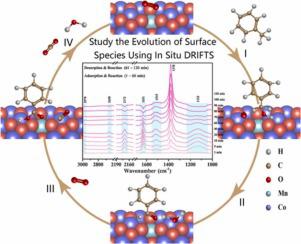Sensors and Actuators B: Chemical ( IF 8.0 ) Pub Date : 2021-11-26 , DOI: 10.1016/j.snb.2021.131155 Zhengmao Cao 1 , Wu Wang 1 , Hao Ma 1, 2 , Lei Xiao 1 , Jieyuan Li 1, 3 , Yanjuan Sun 3, 4 , Jianping Sheng 3, 4 , Fan Dong 1, 3

|
Unraveling the gas-solid interfacial sensing mechanism during gas sensing is very essential for the development of high-performance gas sensors. In this work, the Mn-doped Co3O4 porous nanosheets with 5.6 times higher response than pristine Co3O4 and short response/recovery time (55/30 s) for 100 ppm toluene gas is synthesized. More importantly, in situ diffuse reflectance infrared Fourier transform spectroscopy (DRIFTS) is conducted to investigate the gas-solid interfacial sensing mechanism over 3-Mn-Co3O4. The interfacial reaction species have been monitored, such as methylbenzene, benzyl alcohol, benzaldehyde, benzoic acid, carbon monoxide, and water molecule. These species originate from the elementary and overall reactions during toluene gas sensing. The dynamic evolution of surface species could be divided into three stages of adsorption reaction, reaction balance, and desorption reaction. Furthermore, combined with the density function theory simulation calculation, the gas-solid interfacial sensing mechanism over 3-Mn-Co3O4 is proposed. Toluene molecule reacts with the surface active oxygen species resulting in the occurrence of a series of elementary reactions and the generation of intermediates. The products of overall reaction are CO2 and H2O during gas sensing. Our work implements a meaningful exploration of in situ DRIFTS in gas-sensing field and provides a distinctive view to understand the gas-soild interfacial gas-sensing mechanism.
中文翻译:

多孔掺杂 Mn 的 Co3O4 纳米片:使用原位 DRIFTS 进行气敏性能和界面机制研究
解开气体传感过程中的气固界面传感机制对于高性能气体传感器的开发至关重要。在这项工作中,合成了 Mn 掺杂的 Co 3 O 4多孔纳米片,其响应比原始 Co 3 O 4高 5.6 倍,并且对 100 ppm 甲苯气体的响应/恢复时间短(55/30 s)。更重要的是,进行了原位漫反射红外傅里叶变换光谱 (DRIFTS) 以研究 3-Mn-Co 3 O 4 上的气固界面传感机制. 已监测界面反应物质,例如甲苯、苯甲醇、苯甲醛、苯甲酸、一氧化碳和水分子。这些物质来源于甲苯气体传感过程中的基本反应和整体反应。表面物种的动态演化可分为吸附反应、反应平衡和解吸反应三个阶段。此外,结合密度函数理论模拟计算,提出了3-Mn-Co 3 O 4 上的气固界面传感机制。甲苯分子与表面活性氧物质发生反应,导致一系列元素反应的发生和中间体的生成。总反应产物为CO 2和H气体传感期间的2 O。我们的工作对气敏领域的原位漂移进行了有意义的探索,并为理解气-土界面气敏机制提供了独特的视角。






























 京公网安备 11010802027423号
京公网安备 11010802027423号